Oe1mcu (Diskussion | Beiträge) |
Oe1mcu (Diskussion | Beiträge) |
||
| Zeile 100: | Zeile 100: | ||
== Breitband Transformator == | == Breitband Transformator == | ||
| − | Das unten stehende Diagramm zeigt den Aufbau des 5:1 Transformators. Weiter unten sind die Bilder vom Transformator zu sehen den Gernot, OE1IFM aufgebaut hat. Die Ferritringe sollen dem Type 31 Material ähnlich sein und können von CPC mit der Arteikel Nummer CBBR6924 oder CBBR6945 bezogen werden. Beide Typen werden zu fünf verpackt geliefert und können über ein standard 15mm Kupfer Rohr geschoben werden. Bedauerlicherweise waren ware einige der Ferritringe etwas kleiner und haben nicht über das standard Kupfer Rohr gepasst. Wenn dieses Problem auftritt kann ein Kupferrohr aus dem Modellbau bezogen werden.<br> | + | Das unten stehende Diagramm zeigt den Aufbau des 5:1 Transformators. Weiter unten sind die Bilder vom Transformator zu sehen den Gernot, OE1IFM aufgebaut hat. Die Ferritringe sollen dem Type 31 Material ähnlich sein und können von CPC mit der Arteikel Nummer CBBR6924 oder CBBR6945 bezogen werden. Beide Typen werden zu fünf verpackt geliefert und können über ein standard 15mm Kupfer Rohr geschoben werden. Bedauerlicherweise waren ware einige der Ferritringe etwas kleiner und haben nicht über das standard Kupfer Rohr gepasst. Wenn dieses Problem auftritt kann ein Kupferrohr aus dem Modellbau bezogen werden.<br><br> |
[[Bild:G8JNJ Transformator.jpg|400px|]] | [[Bild:G8JNJ Transformator.jpg|400px|]] | ||
Aktuelle Version vom 13. Dezember 2009, 01:46 Uhr
Grundlagen der Breitband Kurzwellen Antenne nach Martin - G8JNJ
Übersetzung mit der freundlichen Genehmigung von G8JNJ (http://g8jnj.webs.com/)
| Wichtiger Hinweis:
Die Antenne wurde von Gernot, OE1IFM nachgebaut. Tipps und Teile stellt er gerne zur Verfügung. |
Martin, G8JNJ hat eine breitbandige vertikal Antenne entwickelt die ohne Anpassgerät auf allen Kurzwellen Bereichen von 7MHz bis 30MHz (mit eingeschränkter Leistungsfähigkeit von 3.5MHz bis 51MHz) betrieben werden kann. Bitte beachten Sie das die zu erwartende Leistungsfähigkeit der Antenne nur die eines 7m Rundstrahlers ist und nicht mit einer Yagi auf den höheren Bändern oder Lamda/2 Dipol auf den tieferen Frequenzen zu vergleichen ist.
Die beschriebene Antenne wurde nach aufwendigen Tests mit einer Comet CHA-250 mit einem speziell angefertigten 6:1 Transformator entwickelt. Es wurden viele andere Bauformen aufgegriffen und wieder verworfen bevor die unten vorgestellte Version gefunden wurde.
Impedanz des Strahler
Das Prinzip der Antenne ist das die Länge des Strahlers so gewählt wurde das der die Impedanz der Antenne auf den meisten Amateurfunk Bändern gleich ist. Ein spezieller Anpassungs- Transformator am Speisepunkt der Antenne transformiert die Fußpunkt Impedanz in die Nähe von 50 Ohm.
Die Antenne kann direkt über der Erde oder an einem isolierten Mast betrieben werden. Der Betrieb an einem Mast erhöht die Leistungsfähigkeit (darauf wird später eingegangen). Die Graphik zeigt das gemessene VSWR einer 6,5m vertikal Drahtantenne (um eine 10m Angelrute gewickelt) gegenüber einer Antenne mit 10 eingegrabenen Radials und dem unterschiedlichen Abschlusswiderständen.
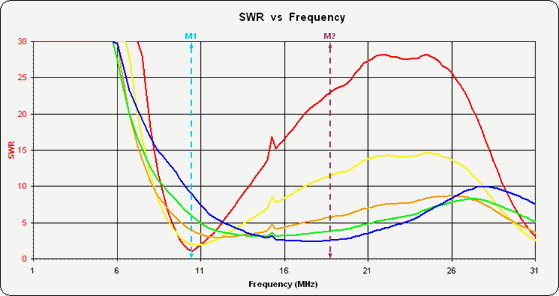
- Der rote Verlauf ist mit 50 Ohm Anschluss
- Gelb mit 100 Ohm
- Orange mit 200 Ohm
- Grün mit 300 Ohm
- Blau mit 450 Ohm
Das geringste VSWR wird mir einem Abschlusswiderstand im Bereich von 200 bis 300 Ohm erreicht.
Die zwei Marker zeigen die Lamda/4 Resonanzstelle M1 bei 10,5 MHz und die Lamda/2 Resonanzstelle M2 bei 21 MHz.
Verluste durch die Anpassung
Wenn die Verluste durch den Transformator und in etwas 2dB durch die Koaxialkabel berücksichtigt werden, das strahlende Element und die Radials gut abgestimmt werden ist es möglich ein VSWR von weniger als 2:1 (Rückflußdämpfung von 10dB) auf den meisten Amateurfunkbändern zu erreichen.
Die Graphik zeigt den Verlust des Transformators. Die blaue Line entspricht dem der Comet Nachbau und die rote Linie dem von G8JNJ entwickelten Transformator. Die Leistungsfähigkeit des neuen Transformators ist deutlich besser als die vorab getesteten. Auch wenn ein ferngesteuertes Antennenanpassgerät am Ende der verlustarmen Koaxialleitung eingeschliffen wurde waren keine Verbesserungen mehr im abgestrahlten Signal messbar. Ausgenommen waren die Frequenzen 1,9MHz und 3,6MHz wo eine Verbesserung von ca. 2dB messbar waren).
Die Durchgangsdämpfung ist deutlich geringer als die originale Version und der Aufbau der Antenne weist eine verbesserte Abstrahlungseffizienz bei geringfügig schlechterer Anpassung aus. Wie auch immer, durch die reduzierte Durchgangsdämpfung (und dem daraus beeinflussten VSWR) ist das VSWR der Antenne geringfügig höher als das VSWR der Comet Antenne.
Anpassung
Die Graphik zeit das VSWR gemessen an der Basis eines 6,5m hohen Vertikalstrahler getragen durch eine 10m Angelrute.
- Die rote Linie zeigt die direkte Anspeisung
- Die grüne Line zeigt das VSWR mit einem 300Ohm Abschluss
- die orange Line zeigt den VSWR Verlauf mit dem Nachbau des Comet Transformators.
- die blaue Line zeigt den VSWR Verlauf mit dem von G8JNJ Transformator.
Die zwei Marker zeigen die Lamda/4 Resonanzstelle M1 bei 10,5 MHz und die Lamda/2 Resonanzstelle M2 bei 21 MHz.
Zu beachten ist das der Transformator bei den tieferen Frequenzen eine höhere Einfügedämpfung aufweist und damit das VSWR verbessert wird. Weiter Verbesserungen der Anpassung kann durch den Einsatz kurzer Radiale oder einem Gegengewicht aus Kabeln anstelle des großen Radialsystems in der Erde erzielt werden. Das verbessert den ohmschen Widerstandsanteil der Antennenimpedanz bei der niedrigsten Frequenz. Dadurch reduziert sich der Antennengewinn, der Unterschied im Gewinn der Antenne fällt auf den tieferen Frequenzen kaum ins Gewicht da die Antenne für die Frequenzen von der Konzeption her zu kurz ist und keine große Leistungsfähigkeit zu erwarten ist. Das Wissen um diese Gegebenheit darf niemanden abschrecken, viele Antennenbauformen (auch kommerzieller Fertigung) verwenden die gleiche Technologie - nur verraten sie es nicht!
Viele Leute meinen das 2 oder 3dB Verlust im Anpassungsnetzwerk zu hoch ist. Die von G8JNJ durchgeführten Tests zeigen das auch ein gutes Antennenanpassgerät eine Einfügedämpfung zwischen 0,5 und 1,5dB aufweist, und viele 4:1 Baluns, speziell die Bauform mit Windungen um Eisenpulverkerne können Einfügedämpfungen zwischen 1 und 3dB aufweisen, speziell dann wenn die Einspeisung eine niedrige Impedanz oder einen hohen Blindanteil aufweist. So sind 2 bis 3dB im Durchschnitt zu erwarten, viele Funkamateur haben diese Dämpfungswerte bereits in Ihrer Sendeleitung ohne es zu wissen, denn sie haben sich nicht die Zeit genommen um es zu messen.
Das untenstehende Diagramm zeigt das gemessene VSWR mit einem 10m langem Koaxialkabel an der Basis der Antenne. Zusätzliche Verluste in der Zuleitung verbessern das VSWR zusätzlich. Wenn ein typisches Koaxialkabel mit einer Däpfung 1 bis 2dB angeschlossen wird verbessert sich das VSWR von 3:1 auf 2,3:1 mit einer Dämpfung im Koaxialbkabel von 1dB und von 3:1 auf 1,9:1 mit einer Dampfung von 2dB im Koaxialkabel.
| Frequency | Gain | VSWR |
| 1.9 MHz | -26dBi | 8.5:1 |
| 3.6 MHz | -6dBi | 4.2:1 |
| 7.1 MHz | +1dBi | 2.1:1 |
| 10.1 MHz | +1dBi | 1.75:1 |
| 14.1 MHz | +1dBi | 1.46:1 |
| 18.1 MHz | +3dBi | 1.94:1 |
| 21.1 MHz | +4dBi | 2.25:1 |
| 24.9 MHz | +4dBi | 2.73:1 |
| 29 MHz | +2dBi | 2.38 |
| 51MHz | +1dBi | 1.5:1 |
Strahlungsdiagramm
Eine bessere Bewertung der Leistungsfähigkeit kann aus dem unterstehenden Diagramm entnommen werden. Zu beachten ist das der Abstrahlungswinkel bei bei 29MHz und 51MHz ansteigt und dadurch der Gewinn geringer ausfällt.
Aufbau der Antenne
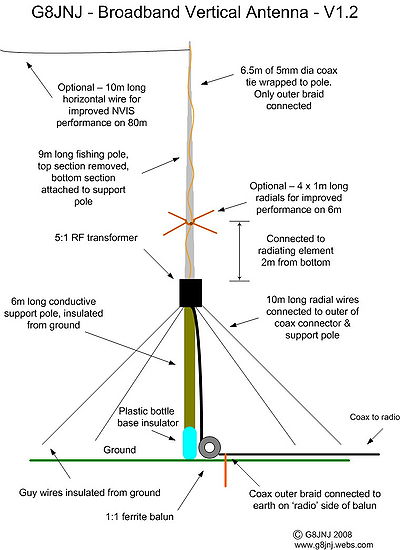
|
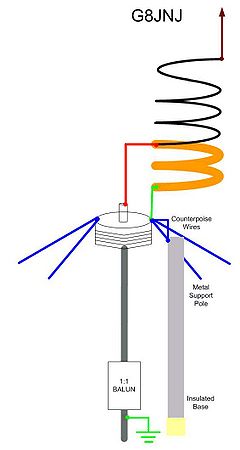
|
Breitband Transformator
Das unten stehende Diagramm zeigt den Aufbau des 5:1 Transformators. Weiter unten sind die Bilder vom Transformator zu sehen den Gernot, OE1IFM aufgebaut hat. Die Ferritringe sollen dem Type 31 Material ähnlich sein und können von CPC mit der Arteikel Nummer CBBR6924 oder CBBR6945 bezogen werden. Beide Typen werden zu fünf verpackt geliefert und können über ein standard 15mm Kupfer Rohr geschoben werden. Bedauerlicherweise waren ware einige der Ferritringe etwas kleiner und haben nicht über das standard Kupfer Rohr gepasst. Wenn dieses Problem auftritt kann ein Kupferrohr aus dem Modellbau bezogen werden.
Wie gut funktioniert die Antenne ?
Das hängt vom Vergleich ab und auch welchen Frequenzen verglichen wird. Der Vergleich gegenüber einer hy-gain 19AVT sieht gut aus, gegenüber einen 40m Draht auf den niedrigen Frequenzen sieht es schlecht aus (es sind 8 bis 10dB auf 80m und 20 bis 30 dB auf 160m zu erwarten).
Ein fairer Vergleich kann nur mit einer Antenne mit gleichen Strahler- und Gegengewichtlänge gezogen werden wo ein anstatt des Anpassungstransformators ein automatischer Antennentuner eingesetzt wird. So wurde der Vergleich auch gemessen und die die Leistungsfähigkeit verglichen. Natürlich ist die Version mit dem Breitband Transformator immer schlechter als die Version mit dem Antennentuner, jedoch erscheint der Leistungsverlust der Antenne mit Anpassungstransformator durch die Breitbandigkeit und die Möglichkeit es deutlich günstiger zu realisieren als aufgehoben.
Zusammenfassend kann davon ausgegangen werdend das die Antenne so gut wie andere Multiband-Antennen mit gleicher Höhe auf den Bänderen größer als 40m funktioniert, aber nicht so gut auf den Bändern unter 40m.
Warum kann ich Stationen hören die aber hören mich nicht ?
Man erwartet wenn man Stationen hören kann diese auch zu erreichen, wie auch immer, der niedrige Rauschpegel beim Empfang kann manchmal einen einen guten Empfang auf den niedefrequenten Bändern ermöglichen der bei größeren Antennen durch einen höheren Rauschpegel (QRM und QRN) nicht möglich ist. Zusammengefasst sind die Signale leiser aber das Signal - Rausch - Verhältnis (SNR) ist besser.
Das ist mit der DX Empfang möglich, und es scheint das die Antenne sehr gut für den Empfang - aber eventuell nicht so gut beim Senden funktioniert. Das erscheint als sehr seltsam, denn es wird hier eine reziproke Leistung erwartet.
Yet sometimes I call stations on the vertical and they don't come back, switch over to the other antenna and they do, even though on receive they are the same strength, it's a very odd phenomenon but I suspect it's simply down to a better receive S/N ratio on the vertical (as opposed to the absolute signal strength). I find it works well as a receive antenna on 160m and one constructor John, G4IJD, has heard a ZL station on 80m at reasonable strength. In comparisons I have found it outperforms a Datong active antenna mounted at the same height.
Was ist die Resonanzfrequenz der Antenne ?
Die Basis der Antenne ist das sie auf den gewünschten Frequenzen nicht resonant ist.
Die Antenne wurde entwickelt das die Impedanz des Strahlers auf den gewünschten Frequenzen nahe der der sekundären Impedanz des Transformators ist um maximalen Energietransfer zu erzielen. Die Verwendung eines 7,1m langen strahlenden Elements ist nicht zufällig (das strahlende Element ist aktuell eine Lamda/4 Wellenlänge bei der Frequenz 10,4MHz lange). Das ist ist es eine umsetzbare Impedanz auf den gewünschten Frequenzen zu erzielen wobei die Strahler nicht zu lange sein darf (unter Lamda 5/8) für einen effizienten Betrieb auf 28MHz und 50MHz. Wenn das vertikale Element zu lange gewählt wird die Leistung in einem höheren vertikalen Winkel abgestrahlt, was den nutzbaren Gewinn (für Weitverbindungen) reduziert.
How can I further improve its performance ?
The main problem is balancing the parameters of maximum vertical length (which needs to be kept below 5/8 wave at the highest frequency), sufficient length to be efficient at the lowest frequency, a moderate feed impedance (to suit the transformer ratio) for the radiating element at all frequencies required for TX, and ideally some horizontal component to keep the folks who require NVIS performance on 80m happy.
You could replace the transformer with an auto-tuner, increase the number and length of radials, increase the height of the support pole, use lower loss coax, increase the transmit power, add an 80m long offset top loading wire. The permutations are endless - but it’s not the antenna you started with !
How can I make it work better on the LF bands ?
Performance on 80m is a bit of a compromise. I think it’s about 6dB down on an equivalent length radiating element and counterpoise, but with an auto-atu in place of the transformer. Feeding the transformer with a remote atu made about 2dB improvement on 80m over the transformer alone. On the HF bands adding a remote atu made very little difference.
However the perceived lack of performance may be due to several factors. One is that it’s a lot shorter than a ¼ wavelength on the LF bands, another is that being a vertical it has very little upward radiation, so it is a poor performer for NVIS coverage on 1.9 and 3.6MHz. Hence once you get outside the ground wave coverage there is nothing until past about 500 Miles so it’s very poor for semi-local contacts.
The main difficulty is managing the impedance presented by the radiating element on the LF bands. For example a 7m long wire over an average ground plane on 1.9MHz is typically 10 – J1310 and on 3.6MHz 10.5 –J640. As you can see the resistive element is very small in relation to the transformer secondary impedance and the reactive component is very much greater and capacitive. With my transformer design I have tried to roll off the impedance ratio at the LF end to get a closer match to the radiating element but it’s still a long way out. From this I hope you can get a good feel for what design parameters can be traded, and those which will remain a compromise. The ideal efficient broadband antenna is a ‘holy grail’ for antenna designers, and I’m sure there are a lot more qualified persons than myself who haven’t found it yet.
John, G4IJD suggested using the antenna in a horizontal configuration. I have been playing with this idea, and the best configuration so far seems to be something like an 11.2m horizontal wire at 10m above ground, with the transformer also at 10m, fed with coax and with the 1:1 choke balun fitted to the coax at 2m above ground.
However I suspect that the mechanical difficulties of supporting the transformer at 10m may make an inverted L easier to implement.
To achieve this all that's required is the addition of a horizontal wire at the top of the existing vertical section.This would add an NVIS component, increase the radiation resistance and improve the efficiency on 80m. The question is, how long should the horizontal wire section be. I suggest keeping the vertical section the same length as the original design, but add a horizontal wire of length 12.2m or 27.2m long, to make the total length of radiating element either 19.2m or 34.2m.
These lengths should not present an impedance of much greater than 1K on any of the desired transmit frequencies.You can use the LVD programme on this website to give an estimation of feed impedance if you wish to experiment with other lengths (also see my notes relating to auto-tuners). Using a 12.2m horizontal top wire will add a useful NVIS component on 3.6MHz, but you really need to get upto 27.2m long before it becomes effective. However at this point the antenna is starting to become fairly large. Another option would be to use two top (or more) wires of differing lengths say a ratio of 1/3 & 2/3 in order to provide mismatched currents which would result in better NVIS coverage.
Eine andere Idee ist eine spiralförmige Windung für 80m, aber aus dem Draht aus gespeist aus dem 2,5mm Kupferkabel das die beiden Kupferröhren verbindet. An diesem Punkt ist eine niedrige Impedanz die für die 80m Windungen sehr gut passt. Wie auch immer, die Bandbreite ist beschränkt, und die Wechselwirkung zwischen der spiralförmigen Wicklung und dem vertikalen Draht können nicht vorhergesagt werde, aber es ist ein Experiment wert.
Ergänzung - John, G4IJD, hat es ausprobiert, aber die geringe Verbesserung die mit der Modifikation erreichbar ist gerechtfertigt den Aufwand nicht. Ein zusätzlicher, horizontaler oben liegender Draht erscheint als bessere Lösung.
Another alternative would be to try using the transformer to feed something like a 60m dia horizontal loop, which would also improve NVIS coverage on the LF bands.
How can I make it work better on 6m ?
Performance on 6m is reduced beacuse of the length of radiating element. Ideally a vertical antenna should not be longer than 5/8 wavelength, or most of the radiated energy tends to fire up towards the sky. I have tried modeling the antenna with a four element capacity hat at various heights, and have found that four 1m long radials attached to the main vertical radiating element 2m above the feed point, results in approximately 6dB more gain towards the horizon. There is still some energy radiated up towards the sky, but this is more than offset by the improvement in gain at low angles. This modification does result in a slight reduction in gain on 10m, but this may be a worthwhile trade. So far I have not had the opportunity to try this, but hope to do so in the near future.
Could I use some other form of loading ?
There is a problem in adding any form of loading as it introduces varying impedances at other frequencies. A loading coil or trap which is introduced to improve performance on the LF bands will have an impact at the HF end. The least problematic method would be to add a loading coil towards the top of the radiating element and / or capacitive loading. A technique such as Petlowany loading is also a possibility, see my washing line antenna.
John, G4IJD, has been experimenting with capacity hat loading, using four sloping wires from the top of the radiating element. I have included some of John's comments below
>>>Having first established that my effort came close to your results ( base of antenna still at about 3m agl) my "gut" feeling was that T (or maybe capacity since T is really out of the question) loading would improve the match on top band and 80m without significantly altering the loading on the HF bands.
For test purposes I have attached 4 wires, all equal in length to the main element, to the top of the antenna.By bringing these wires out from the base I can see any effect on the matching quite easily.
Using all four wires extended out to about 5m from the base at 90 degrees to each other, the VSWR on top band drops to about 1.4:1 when measured at the transmitter and so an ATU is not required. Matching on all other bands can then be taken care of by an ATU. To return everything to normal I simply connect all wires together at the base of the main element.Haven't tried all combinations yet but will keep you posted.
I have no idea what effect this has on the radiation pattern but in my situation the extra wires double up as guy wires and stabilise the antenna in high winds thus boosting neighbour confidence. Of course all this is possible because the base is easily accessible from a ladder.
I think this antenna will appeal to a lot of people as long as they read all your notes and don't expect too much from it. As an all band convenience antenna it's ideal for me. I can think several uses for a second one. <<<
More analysis of this is required, but it struck me that the wires could be brought bact to the base of the radiating element to form a cage folded monopole, perhaps something like this. Some broadband military HF antennas use this technique, often in conjunction with a high power terminating resistor.
Why did you use coax cable as the radiating element ?
When I modelled the antenna I found I got better results using a larger diameter conductor. I reduced the diameter until the results started worsen. The best compromise was to use a diameter of around 10mm, and coax cable was the cheapest option. If you have aluminium tube or an old CB antenna this would be better still. Just cut the length so that it is a ¼ wave at 10.4MHz as this will give the correct matching impedance at other frequencies. If you need to use a shorter support pole it is possible to use a ‘lazy’ helical winding for the radiating element, say up to 4 turns per metre length it should be OK, however this technique tends to introduce unpredictable secondary resonances which could put ‘lumps and bumps’ into the frequency response.
How critical is the height of the mounting pole and the length and number of radials ?
They are not too critical, for example, three 5m long radials would be fine, however I would suggest that all the radials or counterpoise wires and the mounting pole are not connected to ground and the length does not exceed 10m. You may wish to experiment with the lengths and ‘angle of dangle’ to achieve the best impedance match on the required frequencies. On the LF bands longer radials would be better but you could try adding say two inductively loaded radials tuned on the LF bands of interest. As I previously stated you can mount it higher or lower within certain limits. But if this is not easy you could consider ground mounting with at least four radials. In this case adding more radials will further improve the performance.
I have obtained very good results by mounting this antenna on top of a building with a metal clad roof. I did not use any radials, but mounted the transfomer close to the edge of the roof and connected it to the cladding with a short metal strap.
If either of these two methods are not possible, you can ground mount the antenna and connect it to as many radials as possible. However the gain will be significantly lower than using an elevated feed and counterpoise / radials.
Why is there a 1:1 choke balun at the base of the mast ?
The purpose of this is twofold. It is designed to provide a high impedance ‘break’ in the feed cable at a specific point so that the vertical section of the coax (and the support pole it runs along) is ‘lifted’ above ground to form a counterpoise, the whole antenna then becomes similar to an off-centre fed vertical dipole. If the balun was fitted at the top of the pole, there would still be coupling between the outer of the coax below the balun and the support pole. The second purpose is to prevent electrical noise and other unwanted interfering signals which may be carried on the outer of the coax from being conducted into the receive path. It also eliminates RF on the coax when used for transmit purposes.
Please note that simply using coiled coax as a balun does not provide a high enough choking impedance for this purpose.
Can I use chokes from CRT monitor cables or some others I have in my junk box ?
I have tried a large selection of ferrite materials, including some which I have recovered from scrap CRT PC monitors. There is a very large variation between types (even those from the same make and model) I think they just use whatever they can get hold of. If you have a large number (at least 10 and ideally 30 - 40 or more for 1.9 & 3.6MHz) and thread them over coax they can be used for the 1:1 balun to suppress noise which would otherwise be induced on to the received signal. However the variation in characteristics makes them difficult to use for the transformer, if you wish to obtain repeatable results. Also be very careful about ring cores you buy at radio rallies or on e-bay. Many of these are actually made from iron powder, and are designed for low frequency (əMHz) use in switched mode power supplies. They are not suitable in this application. If you have an impedance measuring bridge you can test them to see if they are made of ferrite. As a rule of thumb with one turn you should obtain about 2.5uH at 2MHz, 1uH at 10MHz and 0.4uH at 30MHz for a 20 x 30mm core with 7mm dia hole if it is similar to type 43 material. However if you do this I cannot guarantee it will work as well as a transformer made with the specified parts.
Do I have to use copper or brass tube ?
No, Wolfgang, OE1MWW has successfully used braid from RG213 coax. He also tried using just a single wire loop, but found that the closer coupling provided by the coaxial tube winding produced much better results.
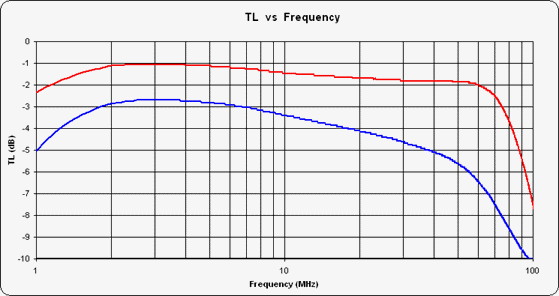
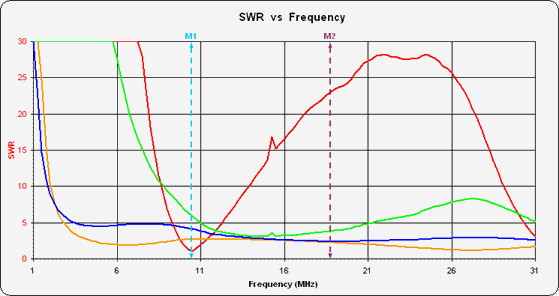
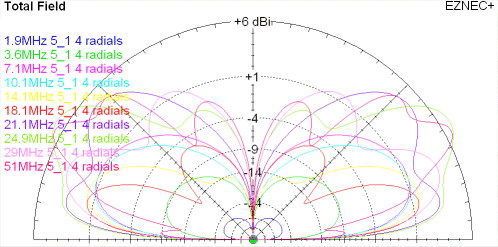
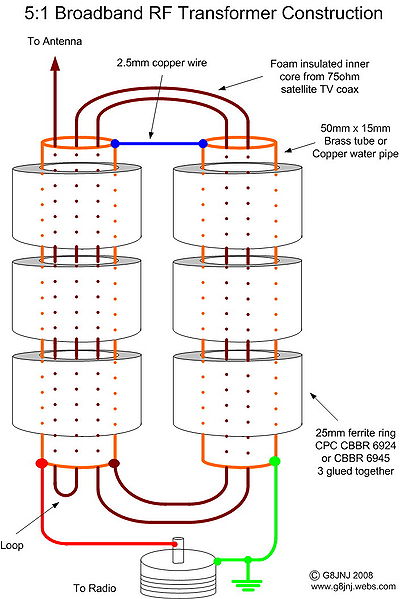





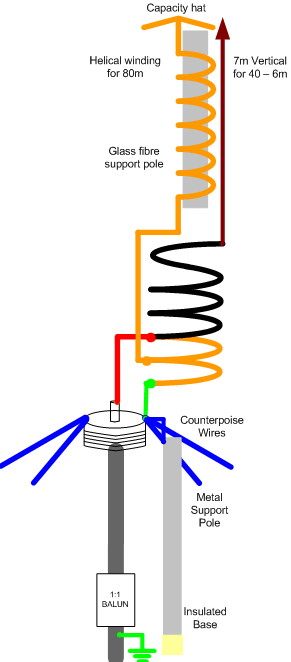
Diskussionen